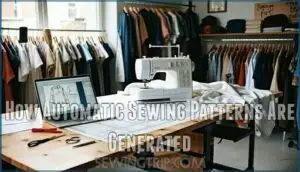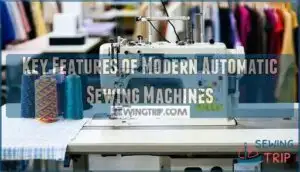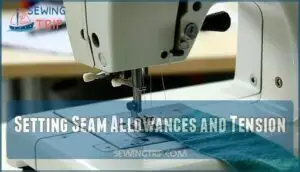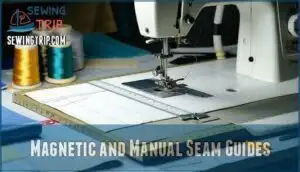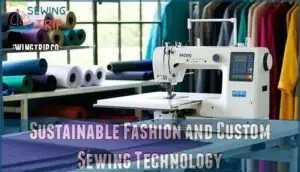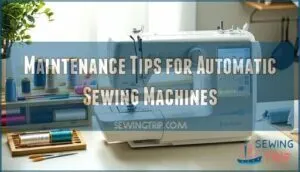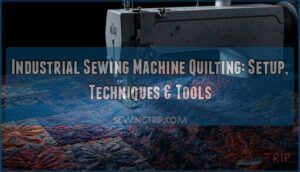This site is supported by our readers. We may earn a commission, at no cost to you, if you purchase through links.
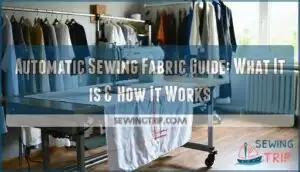
Automatic sewing fabric guides lock your material into position and keep it there—no visual babysitting, no constant hand-correcting, no ruined seams. These systems use sensors, magnetic rails, and laser projections to maintain exact seam allowances while you focus on speed and creativity.
Whether you’re running production batches or perfecting a single garment, automated guidance transforms guesswork into mechanical certainty.
Table Of Contents
- Key Takeaways
- What is an Automatic Sewing Fabric Guide?
- How Automatic Sewing Patterns Are Generated
- Key Features of Modern Automatic Sewing Machines
- Using Fabric Guides for Accurate Sewing
- Integrating Robotic and Automated Sewing Systems
- Sustainable Fashion and Custom Sewing Technology
- Maintenance Tips for Automatic Sewing Machines
- Frequently Asked Questions (FAQs)
- Conclusion
Key Takeaways
- Automatic sewing fabric guides use sensors, magnetic rails, and laser projections to maintain precise seam allowances without constant manual adjustment, transforming guesswork into mechanical certainty and eliminating the fabric drift that ruins seams.
- Modern parametric design systems like FreeSewing generate custom-fit patterns from your exact body measurements in real-time, breaking free from standard sizing limitations and delivering centimeter-level precision without recurring subscription fees.
- Automated sewing technology reduces textile waste by 10-15% through AI-driven fabric nesting and precision cutting while supporting slow fashion principles—custom garments last 35% longer because they fit actual bodies instead of averaged measurements.
- Regular maintenance including proper lubrication every 8-10 hours of use, weekly lint removal from tension discs and feed dogs, and manufacturer-recommended oil prevents friction damage and keeps automatic machines delivering consistent stitch quality for years.
What is an Automatic Sewing Fabric Guide?
An automatic sewing fabric guide keeps your material aligned while you sew—no guesswork, no wandering seams. It’s the difference between wrestling with fabric and letting the machine do the heavy lifting.
Let’s break down what it’s, how it stacks up against manual guides, and the types you’ll encounter.
Definition and Key Functions
An automatic sewing fabric guide is your hands-free partner in keeping fabric aligned perfectly as it moves through the machine—think of it as guardrails that prevent your seams from wandering off course.
Here’s what makes these tools essential for precise sewing machine operation:
- Maintains consistent seam allowance without constant visual monitoring during fabric guidance
- Reduces material waste through accurate pattern making and sewing mechanics
- Speeds up workflow by eliminating manual adjustments in automatic sewing systems
- Improves measurement tools accuracy for professional-grade sewing basics and fabric selection
Differences From Manual Sewing Guides
You’ve seen how automatic guides keep your fabric on track—but what separates them from their manual counterparts? Manual sewing guides demand constant hands-on adjustment and visual monitoring of seam allowance, while automated controls manage fabric precision through sensors and digital menus.
This shift in sewing machine operation boosts sewing efficiency by cutting setup time and error reduction through pre-programmed stitch variety. Automatic sewing patterns leverage these fabric guidance systems to deliver consistent sewing techniques without the guesswork that slows down manual methods.
The use of sewing robots can further improve the efficiency and precision of the sewing process.
Types of Automatic Fabric Guides
Knowing the difference matters, but choosing the right guide for your project makes all the difference. Fabric feeders push material through at steady speeds, while automatic cutters trim precisely without your scissors.
Laser guides project seam lines directly onto fabric—no guesswork. Precision rulers snap into place magnetically, and smart sensors adjust tension automatically.
Modern automatic sewing machines combine these features with sewing automation that turns complex patterns into reliable results.
How Automatic Sewing Patterns Are Generated
Forget cookie-cutter patterns that never quite fit. Automatic sewing patterns break free from standard sizing by building your design from scratch using your exact measurements.
Here’s how the technology transforms numbers into custom-fit patterns you can actually use.
Role of Custom Body Measurements
Your measurements aren’t just numbers—they’re the blueprint that separates a garment that fits from one that actually belongs to you. Custom measurements drive body fit analysis, capturing everything from bust circumference to vertical torso length.
Measurement accuracy transforms custom pattern making from guesswork into precision engineering.
When you input your fit preferences—whether you want close-fitting sleeves or relaxed shoulders—you’re controlling the sewing ergonomics that make made-to-measure garments feel seamless to wear.
Parametric Design Vs. Standard Sizing
Standard sizing charts force real bodies into averaged boxes. Parametric design flips that script—it builds garment construction around your body measurement, not historical population data.
Where traditional sizing offers maybe eight discrete sizes and linear grading rules that fail at the extremes, parametric sewing patterns generate tailored fit in minutes using adaptive algorithms. You get centimeter-level fit analysis, lower return rates, and patterns that actually address edge-case body shapes standard sizing ignores.
This approach utilizes parametric modeling techniques to create tailored garments.
FreeSewing and Open-Source Platforms
FreeSewing breaks the paywall that’s kept custom patterns locked behind subscription fees and proprietary software for decades. This open source tools revolution puts parametric design in your hands—no gatekeepers, no recurring charges.
Here’s what you control:
- Pattern customization with real-time editing that adapts to every measurement change
- Community engagement through shared digital patterns and collaborative improvements
- Automatic sewing patterns generated instantly from your exact body data
Digital sewing finally belongs to you, not corporate pattern libraries.
Key Features of Modern Automatic Sewing Machines
Modern automatic sewing machines aren’t your grandmother’s treadle—they’re packed with tech that takes the guesswork out of garment construction. These tools give you precision, speed, and control that manual machines can’t touch.
Here’s what separates today’s machines from yesterday’s models.
Automated Threading and Cutting
Threading a needle and trimming thread tails used to eat up more time than the actual sewing—but automatic threading and cutting systems changed that game entirely. Modern sewing machines feature auto cutters and automated thread management that slash setup time and keep fabric flow uninterrupted.
You’re getting precision stitching without the tedious busywork—that’s real sewing efficiency. These sewing automation features, found in sophisticated robotic sewing machines and digital sewing technology, put control back in your hands by managing the small stuff automatically.
Stitch Options and Digital Controls
Digital controls turned sewing machines into command centers—tap a screen and you’re switching from a straight stitch to a buttonhole, adjusting tension, or programming decorative patterns without fumbling through mechanical dials. These digital displays give you instant access to sewing algorithms that manage thread tension and stitch editing automatically.
- Fabric sensors detect material thickness and adjust pressure
- Automated sewing systems store custom stitch sequences
- Digital sewing technology lets you preview patterns before execution
- Sewing automation eliminates guesswork from tension settings
- Modern sewing machines learn your fabric preferences over time
You’re in total command—no more trial runs or wasted material.
Real-Time Pattern Customization
Imagine tweaking a pattern on your screen and watching it morph to your exact measurements in seconds—that’s the power you access with real-time pattern customization. Parametric design engines let you drag sliders to adjust sleeve length or waist ease while automated grading recalculates every pattern piece instantly.
You’re generating precision patterns with custom measurements—true made-to-measure automatic sewing patterns that respond to your body’s unique geometry without redrafting from scratch.
Using Fabric Guides for Accurate Sewing
You can’t wrestle fabric into submission with your bare hands and hope for the best. Fabric guides give you the precision edge you need to keep your seams straight, your measurements locked in, and your project on track.
Here’s how to use them like you mean it.
Proper Fabric Layout Techniques
Getting your fabric laid out right is like building a house—you need a solid foundation, or everything that comes after will be off-kilter. Start with grain alignment—your fabric’s lengthwise threads should run parallel to your pattern’s grainline marking. This isn’t just about following rules; proper grain alignment directly affects seam precision and fabric tension throughout the entire garment.
Lay your pattern pieces strategically for pattern optimization and smart fabric cutting that minimizes waste.
Setting Seam Allowances and Tension
Once your fabric’s aligned, you need to lock in consistent seam allowances and dial in your thread tension—because even a millimeter’s drift can throw off your entire fit.
Your sewing machine’s tension control adjusts how tightly the thread pulls through fabric layers, preventing puckering or loose stitches. Match thread tension to fabric stretch characteristics—knits need gentler tension than wovens to maintain sewing accuracy and structural integrity.
Magnetic and Manual Seam Guides
Your seam guide—whether it’s a magnetic strip that clamps onto your throat plate or a simple piece of tape—is the difference between eyeballing your seam allowance and nailing it with machine-like precision every single time.
Magnetic seam guides give you instant edge control with adjustable positioning, while manual quilting guides lock down fabric alignment for repetitive cuts.
Both guide systems transform sewing precision from guesswork into engineering-grade seam accuracy—and you’ll feel the difference immediately.
Integrating Robotic and Automated Sewing Systems
Robotic sewing systems aren’t science fiction anymore—they’re reshaping how we think about garment production and fabric management. Understanding how these machines work and where they fit helps you decide if automation belongs in your workshop or factory.
Let’s break down the mechanics, fabric control tech, and real-world applications that make robotic sewing possible.
How Sewing Robots Operate
Precision meets velocity when a sewing robot transforms flat fabric into finished seams—no human hands required. Robot arm movement follows a sewing algorithm that calculates exact stitch paths, while automated cutting and precision stitching deliver consistent results at industrial speed.
These automation solutions maintain fabric tension throughout each cycle, letting robotic sewing machines like Sewbot execute complex patterns faster than any manual operation.
Fabric Handling Technologies
Behind every impeccable stitch lies a battle with fabric tension—one that smart sensors and robotic feeders now win without breaking a sweat. Automated cutting systems slice material with laser-guided precision, while material alignment tech keeps edges true, even when running complex automatic sewing patterns at speed.
Sewbot and other robotic sewing machines rely on servo-driven conveyors and soft grippers to manage delicate textiles, proving that automated sewing isn’t just faster—it’s smarter, too.
Integration for Home and Industry
Bridging garage workshops and factory floors doesn’t take a miracle—just the right balance of automation, ambition, and a deep respect for what makes a seam hold. Here’s how textile integration reshapes both worlds:
- Industrial automation handles high-volume apparel runs while sewing robots master upholstery with fabric efficiency.
- Home decor enthusiasts adopt sewing automation to create custom pieces using automatic sewing patterns.
- Sewing innovation scales from desktop machines to full-line automated sewing systems.
- Textile integration unites craftsmanship with robotic precision across every application.
Sustainable Fashion and Custom Sewing Technology
Automation isn’t just making sewing faster—it’s helping you sew smarter and waste less. When you combine precision technology with custom patterns, you’re stepping away from the throwaway culture that’s choking our planet.
Here’s how modern sewing tech puts sustainability right in your hands.
Reducing Textile Waste With Automation
Automation isn’t just about speed—it’s about making every inch of fabric count. Automated cutting machines reduce offcuts by up to 15%, while AI-driven fabric nesting saves 10-12% per batch. You’re not just sewing smarter; you’re actively shrinking the waste stream. With textile recycling machines projected to capture 61.2% of market revenue by 2025, industrial automation transforms how we manage textile waste from production floor to circular economy.
| Automation Technology | Waste Reduction Impact |
|---|---|
| Automated Cutting Systems | 15% fewer fabric offcuts |
| AI Fabric Nesting Algorithms | 10-12% material savings per batch |
| AI-Driven Textile Sorting | 99% accuracy in fabric identification |
| Automated Inventory Management | 25% reduction in post-production waste |
Sustainable manufacturing through sewing automation means you’re engineering efficiency into every seam. When automatic sewing patterns refine fabric layouts before you even thread the needle, waste reduction becomes built into the process—not an afterthought.
Supporting The Slow Fashion Movement
True power lies in breaking free from the tyranny of mass production. Slow fashion isn’t a trend—it’s your rebellion against disposable culture, and automation becomes your weapon. Made-to-measure garments last 35% longer because they fit your body, not some phantom average. Custom measurements mean you’re engineering garment longevity into every stitch, while sustainable materials meet fashion ethics at the intersection of precision and conscience.
- Open-source sewing patterns saw 300% more downloads between 2023 and 2025, democratizing eco-friendly fashion for over 1.2 million makers worldwide
- On-demand automated production slashes unsold inventory by 30%, eliminating the waste fast fashion built its empire on
- Textile recycling integration with digital workflows has cut paper prototype waste to near-zero while supporting sustainable fashion certification requirements
Community-Driven Pattern Sharing
When thousands of sewists start trading patterns like recipes, the whole game changes—and corporations hate it. Community engagement through platforms like FreeSewing transforms pattern collaboration into open source designs where shared resources fuel co-creation.
You’re uploading custom measurements, tweaking pattern customization with digital sewing tools, and the sewing community thrives on resources nobody can monetize or control. That’s liberation through collective knowledge.
Maintenance Tips for Automatic Sewing Machines
Your automatic sewing machine won’t stay sharp forever—it needs regular care to keep performing like new. Think of maintenance as your ticket to years of perfect stitching without unexpected breakdowns or costly repairs.
Here’s what you need to know to keep your machine running smoothly.
Cleaning and Oiling Best Practices
Your machine won’t run forever on grit and goodwill—it needs regular care to keep delivering those impeccable seams you’ve come to expect. Here’s your maintenance protocol:
- Machine Lubrication – Apply sewing machine oil to the hook race and bobbin area after every 8-10 hours of use to prevent friction damage and extend component life.
- Thread Management – Remove lint buildup from the tension discs and feed dogs weekly using a stiff brush, protecting fabric from snags and ensuring consistent stitch quality.
- Oil Change Tips – Use only manufacturer-recommended lubricant on moving parts, wiping away excess to prevent oil stains on your next project.
Troubleshooting Common Issues
Even the best machines throw tantrums—thread snaps, fabric jams, and needles skip stitches like they’re staging a protest. Check tension issues first—misaligned upper and lower tension causes most thread breakage.
Clear machine jamming by removing the throat plate and extracting lint. For fabric snagging, replace worn needles immediately.
Error codes? Your manual holds the decoder ring you need.
Storage and Professional Repairs
Once the last stitch is sewn, how you store your machine determines whether it stays workshop-ready or becomes a repair project itself. Cover it with a dust guard, keep it away from moisture, and unplug between sessions.
For complex issues—motor failures, electrical glitches, or calibration drift—contact a certified technician. Professional repairs beat DIY disasters every time.
Frequently Asked Questions (FAQs)
How to choose the best automatic sewing machine?
Forget the myth that more features equal better results. Focus on sewing speed, fabric compatibility, and user interface first—machines with user-friendly controls and strong motor performance deliver real cost efficiency.
Check Sewing Machine Reviews for Automated Sewing technology trends before committing.
What is an automatic sewing machine?
An automatic sewing machine manages repetitive tasks like threading, cutting, and stitch selection with minimal manual input. These machines use fabric feed systems and automated sewing systems to simplify garment construction, embroidery, and upholstery work with precision.
How to take care of automatic sewing machines?
Like a well-oiled machine, your automated sewing system thrives on regular Machine Lubrication and Thread Management. Automated Sewing and Sewing Robots demand consistent care to deliver precision.
Follow maintenance schedules, adjust Sewing Speed for different Fabric types, and master Sewing techniques.
What are the different types of automatic sewing machines?
Think computerized quilting machines, industrial embroidery units, and robotic tailoring machines. Sewing robots manage full garments, while automated cutters prep fabric fast.
Mechanical stitchers power high-speed production, and standard sewing machines now feature automated threading and digital controls.
What makes a good sewing machine?
A good sewing machine balances machine durability with sewing speed and offers strong fabric compatibility.
Look for reliable thread quality, smooth presser foot action, and a sharp needle.
The user interface should feel user-friendly, not intimidating.
How does automated sewing work?
Automated sewing relies on fabric sensors, robotic arms, and smart stitching software working together. Manufacturing technology guides automated cutting and seam alignment.
Sewing robots use robotics in production to replicate hand movements, enabling high-speed industrial sewing automation.
Can automatic fabric guides work with stretch fabrics?
Yes, they work—but stretch fabric demands adjustments. You’ll need to reduce fabric tension, use a walking foot or differential feed for fabric stability, and pair your automatic feed with ballpoint needles.
Sewing elastics and knits in textile manufacturing requires these sewing techniques to prevent distortion.
How do you calibrate a magnetic seam guide?
Position your magnetic seam guide by measuring from the needle to your desired seam allowance using a ruler. Slide the guide along the machine bed until magnetic alignment locks at that exact mark, ensuring sewing precision and consistent fabric tension for accurate seam allowance control throughout your project.
What fabrics work best with robotic sewing systems?
Robots can’t sew linen the way your grandma’s hands can—yet. Woven cotton, polyester knits, and denim excel with sewing robots because they stay flat under grippers.
Smart fabrics and rigid textiles enable precise automated cutting and fabric selection for textile production.
Do automatic guides prevent puckering on lightweight materials?
They help, but won’t eliminate it entirely. Proper fabric tension, precise guide systems, and matched sewing techniques reduce puckering on lightweight materials.
You’ll still need careful thread tension adjustment and appropriate needle selection for delicate weaving structures to achieve true sewing precision.
Conclusion
Imagine never second-guessing a seam again—no ruler checks, no fabric creep, no crooked stitches that force you to rip and redo. An automatic sewing fabric guide delivers that certainty every single time.
It replaces visual estimation with mechanical precision, letting you channel your attention into design, speed, and finishing work that actually matters.
Once you’ve felt the rhythm of perfect, hands-free alignment, you won’t tolerate guesswork again. This isn’t just convenience—it’s control.
- https://www.reddit.com/r/myog
- https://www.voguefashioninstitute.com/the-use-of-robotics-in-garment-manufacturing/
- https://sparrowrefashion.com/2024/10/16/mechanical-vs-computerized-sewing-machine-pros-cons/
- https://standardbots.com/blog/sewing-robots
- https://www.sewmucheasier.com/assets/ebooks/how-to-choose-sewing-machine-guide.pdf

